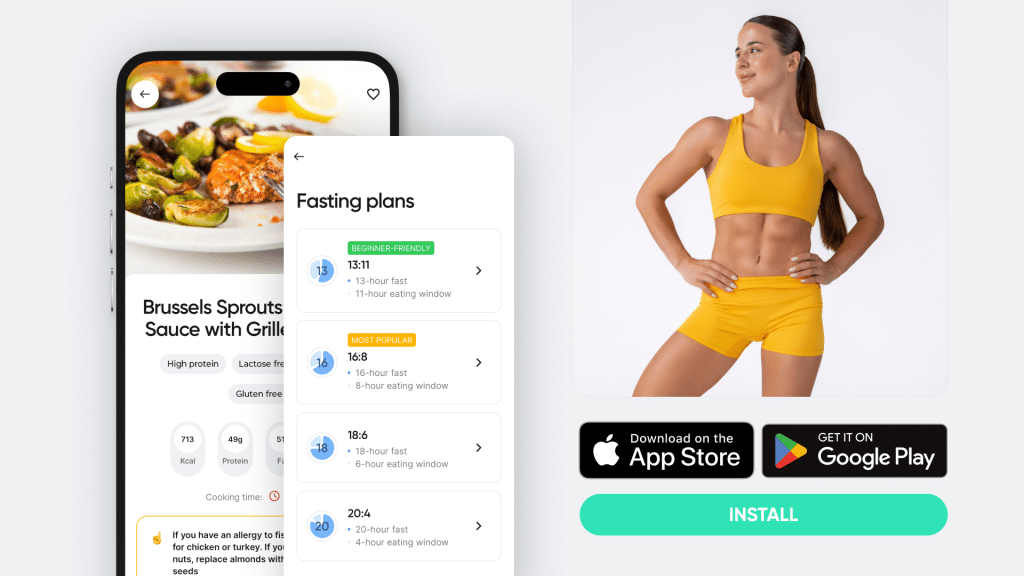Intermittent Fasting (IF) may be an effective way to improve various health metrics, from weight management to blood sugar control and even longevity.
Research suggests that this eating pattern might lead to significant physiological changes that promote overall well-being (7).
However, the body doesn’t instantly switch into a fasting state; there are five stages that your body transitions through during intermittent fasting: the Feasting phase, the Post-Absorptive phase, the Early Fasting phase, the Fasting phase, and finally, the Long-term Fasting phase.
Each of these stages has its unique metabolic adjustments and benefits. For example, during the Early Fasting phase, the body starts using stored glycogen for energy, and the fasting phase is thought to trigger autophagy, a cellular cleansing process.
Let’s review each stage in detail to understand how long you should fast to unlock each benefit.
What Are The 5 Stages of Intermittent Fasting?
Intermittent fasting, a dietary regimen that alternates between periods of eating and fasting, has five distinct stages. These are:
- The Feasting phase
- The Post-Absorptive phase
- The Early Fasting phase
- The Fasting phase
- The Long-term Fasting phase
Let’s discuss the stages of fasting by hour:
1. The Feasting Phase (Fed State)
The first of the 5 stages of intermittent fasting is the Feasting phase. This stage begins as soon as you start eating and continues until your body has fully digested and absorbed all the nutrients from your meal.
During this stage, insulin levels rise to help with nutrient absorption, and the body enters what’s known as an anabolic state, which promotes the building and storing of energy reserves (2).
This is the stage where you decide what to eat during intermittent fasting, with an emphasis on nutrient-rich and balanced meals for optimal health.
BetterMe app will provide you with a host of fat-frying fitness routines that’ll scare the extra pounds away and turn your body into a masterpiece! Get your life moving in the right direction with BetterMe!
2. The Post-Absorptive Phase (Metabolic Transition)
Once your body has finished digesting and absorbing your last meal, typically about 4-6 hours after eating, you transition into the Post-Absorptive phase.
This is one of the key stages of 16/8 intermittent fasting, where your body begins to switch from burning recently consumed calories to burning stored energy. It’s important to understand this transition because this is when intermittent fasting starts to demonstrate its metabolic benefits.
3. The Early Fasting Phase (Fat Burning)
The Early Fasting phase kicks in around 8-12 hours into your fasting window, depending on your metabolism and what you ate during your last meal.
During this stage, your body is using its glycogen (stored carbohydrates) reserves for energy. As glycogen stores start to become depleted, the body will also convert amino acids (the building blocks of protein) to glucose as well as begin to break down fat.
4. The Fasting Phase (Ketosis)
As the Early Fasting phase ends, you enter the Fasting Phase, which might begin around 18 hours into a fast, which may vary depending on individual metabolism.
This stage is characterized by the transition to ketosis as your glycogen stores are likely to be fully depleted. Your body is now breaking down stored fat for energy, which results in the production of ketone bodies.
Some research suggests that this fasting state may promote autophagy – a cellular repair process that removes damaged proteins and cells.
The activation of this process is one of the key stages of catabolic intermittent fasting that is believed to contribute to improved health and longevity (1).
5. The Long-term Fasting Phase (Starvation State)
The final stage is the Long-term Fasting phase, which begins around 48 hours into a fast. This phase is typically reached in extended types of fasting, beyond the usual scope of intermittent fasting 16/8 or even 20/4.
In this stage, your body has adapted to running on stored fat, and hormonal changes occur to preserve lean muscle mass. Long-term fasts that reach this stage are not recommended for most people and should only be performed under medical supervision.
What Are The Stages of Intermittent Fasting for Weight Loss?
When using intermittent fasting for weight loss, your body still goes through the same 5 stages. However, understanding how each stage contributes to weight loss can help you optimize your fasting regime for this specific purpose:
- The Feasting Phase (Fed State): This stage doesn’t directly contribute to weight loss, but it sets the stage for it. Eating nutritious, balanced meals helps maintain your metabolism and keeps your body nourished during the upcoming fasting period.
- The Post-Absorptive Phase (Metabolic Transition): During this stage, your body is shifting from using the food just eaten to stored energy sources. It’s at this point that your body starts to prepare for fat burning.
- The Early Fasting Phase (Fat Burning): This is where the magic starts happening! Approximately 8-12 hours into your fasting window, your body may start burning stored fat for energy, which directly contributes to weight loss.
- The Fasting Phase (Ketosis): By now, you’ve likely depleted your glycogen stores and will soon be entering ketosis, a state where stored fat becomes the primary energy source.
- The Long-term Fasting Phase (Starvation State): This stage usually occurs in extended types of fasting beyond the usual scope of intermittent fasting 16/8 or 20/4. Long-term fasts that reach this stage are not recommended for most people and should only be performed under medical supervision.
So, in terms of weight loss, the real game-changer starts to happen during the Early Fasting Phase, when your body begins to burn stored fat. It’s kind of like your body switching to ‘backup power’.
A 2019 paper published in The New England Journal of Medicine supports this theory, describing how the practice of intermittent fasting shifts the metabolism from storing fat to burning it (5).
That said, the rate of weight loss can considerably vary from person to person. Factors such as your metabolic rate, the composition of your diet, and how active you are all play a part.
So, while the stages of IF remain largely the same, the Early Fasting phase and beyond is where fat-burning kicks in. The key to successful weight loss with intermittent fasting is thought to be hitting that ‘switch’, and of course, consistency in practice and maintaining a balanced diet.
Why Is 16 Hours The Magic Number for Fasting?
For many, the 16-hour fasting window strikes the perfect balance between attainability and effectiveness. It’s long enough for the body to use up a significant portion of its glycogen reserves and start to transition into a fat-burning state, yet short enough to be manageable in everyday life.
Here are the key reasons why 16 hours has become the magic number in intermittent fasting:
Optimized Fat Burning
After about 12 hours of fasting, your body has probably used up a good portion of its glycogen reserves and begins to burn stored fat for energy.
This fat-burning state, known as lipolysis, is one of the major benefits of intermittent fasting (3). With a 16-hour fast, you give your body ample time to switch to this fat-burning mode and reap the rewards.
Practicality and Sustainability
A 16-hour fast fits seamlessly into most people’s routines, making it a realistic and sustainable choice. By skipping breakfast or dinner, you can easily achieve the necessary fasting window without disrupting your daily routine or social commitments. This ease of integration makes it more likely that you’ll stick with the intermittent fasting practice long-term.
Autophagy Activation
Autophagy, the body’s cellular cleansing process, is believed to kick in around 12 to 36 hours into a fast, although we don’t know for sure. A 16-hour fast lands right in this timeframe, offering the potential benefits of autophagy, such as improved cellular function and longevity (1)
Read more: Is Vegan Intermittent Fasting the Right Choice for You?
What Are The Steps for 16/8 Intermittent Fasting?
The 16/8 IF model involves fasting for 16 hours each day and restricting your eating to an 8-hour window. This method is ideal for those new to IF, as it easily melds with most daily routines. Here’s how to get started:
1. Decide On Your Fasting and Eating Windows
The first step in the 16/8 IF journey is to choose your eating and fasting windows. Many people find it easiest to fast overnight, skipping breakfast and beginning their eating window at noon.
This typically means their fasting window is from 8 PM to 12 PM the next day, while their eating window is 12 PM to 8 PM. However, the timing can be adjusted to suit your lifestyle and schedule.
2. Gradual Transition to Fasting
Jumping straight into a 16-hour fast can be a shock to the system, especially if you’re used to eating at regular intervals. It can be beneficial to make the transition gradually. Start by pushing your first meal of the day a little later and your last meal a little earlier, increasing your fasting window bit by bit each day until you reach the 16-hour mark.
Consider starting other types of fasting that may be more manageable for you, such as 14/10 or 12/12, as they require you to fast for shorter hours.
3. Planning Your Meals
Meal planning plays a crucial role in the success of 16/8 IF. During your 8-hour eating window, consume nutrient-dense foods that will sustain you during your fasting period. Prioritize balanced meals that include a good mix of protein, healthy fats, and complex carbohydrates.
4. Hydrate Before, During, and After Your Fast
During the fasting hours, make sure to stay hydrated. Water, black coffee, and tea without milk or sugar are generally acceptable to consume during the fasting period, as they don’t contain calories. Hydration helps manage hunger and keeps you feeling good throughout your fast (4).
When you break your fast, you get a chance to hydrate with nutritious fluids such as bone broth or smoothies. Make sure to drink plenty of water during your eating window as well.
5. Look Out for Negative Symptoms
If 16/8 IF feels too challenging at first, it’s okay to adjust your fasting and eating windows to suit your needs. The goal is to find a sustainable pattern that works for you.
In our post on Keto vs Intermittent fasting, we highlighted the side effects and symptoms to look out for, which are normal and which may indicate an issue.
If you’re feeling unwell, consider breaking your fast and starting again the next day. Remember to prioritize your health and well-being above all else.
Betterme will keep you laser-focused on your weight loss journey! Nutrient-packed meal plans, fat-blasting workouts, galvanizing challenges and much more. Try using the app and see for yourself!
Frequently Asked Questions
Does Fasting Burn Belly Fat?
Yes, fasting can help burn belly fat. When the body exhausts its glycogen reserves during fasting, it begins to burn stored fat for energy, which may include belly fat. However, the effectiveness can vary based on individual metabolic rates and lifestyle factors. Eating fewer calories than you burn, whether through intermittent fasting or another method, is usually required to burn fat. Exercise, especially cardio, is also helpful in burning belly fat.
How Long Does It Take for 16/8 Intermittent Fasting to Work?
The length of time it takes to see results from 16/8 intermittent fasting can vary from person to person, but many people start to notice changes, such as weight loss, after two weeks to a month of consistent practice.
Will a 16-Hour Fast Put Me in Ketosis?
A 16-hour fast may not be long enough to enter ketosis for most individuals. Typically, it takes around 18 or more hours of fasting for the body to fully enter ketosis, the metabolic state where the body uses fat instead of glucose for energy.
Is It Better to Fast for 12 or 16 Hours?
Both 12-hour and 16-hour fasts have their benefits, and the best choice depends on individual lifestyle and health goals. A 16-hour fast may provide more pronounced benefits in terms of weight loss and metabolic health, but a 12-hour fast can be an easier starting point for those new to intermittent fasting.
The Bottom Line
Intermittent fasting has five stages. In the beginning, your body uses up its glycogen reserves for energy. After this, it starts using stored fat for fuel, contributing to potential weight loss.
This process might also trigger autophagy and improve insulin sensitivity, promoting better health in the long run. By selecting a sustainable fasting and eating window, incorporating balanced meals, and staying hydrated, you can reap all the potential benefits
DISCLAIMER:
This article is intended for general informational purposes only and does not serve to address individual circumstances. It is not a substitute for professional advice or help and should not be relied on for making any kind of decision-making. Any action taken as a direct or indirect result of the information in this article is entirely at your own risk and is your sole responsibility.
BetterMe, its content staff, and its medical advisors accept no responsibility for inaccuracies, errors, misstatements, inconsistencies, or omissions and specifically disclaim any liability, loss or risk, personal, professional or otherwise, which may be incurred as a consequence, directly or indirectly, of the use and/or application of any content.
You should always seek the advice of your physician or other qualified health provider with any questions you may have regarding a medical condition or your specific situation. Never disregard professional medical advice or delay seeking it because of BetterMe content. If you suspect or think you may have a medical emergency, call your doctor.
SOURCES:
- Autophagy: cellular and molecular mechanisms (2010,nih.gov)
- Anabolism vs. Catabolism: The Role They Play in Your Metabolism (2021,nih,gov)
- Biochemistry, Lipolysis (2023,nih.gov)
- Can You Drink Water While Fasting? (2023,medicinenet.com)
- Effects of fasting on insulin action and glucose kinetics in lean and obese men and women (2006,journals.physiology.org)
- Effects of Intermittent Fasting on Health, Aging, and Disease (2016,nejm.org)
- Research on intermittent fasting shows health benefits (2020,nih.gov)
- Sample records for intermittent fasting dietary (n,d,science.gov)









